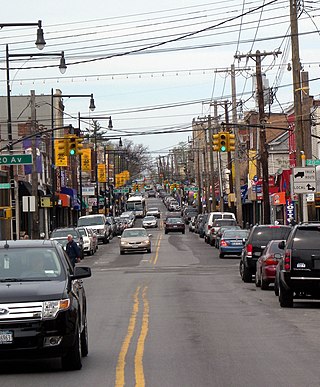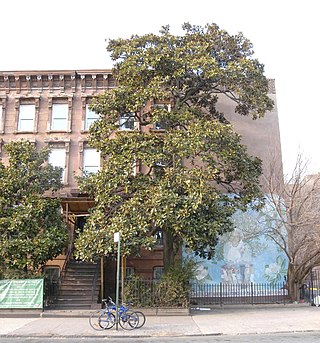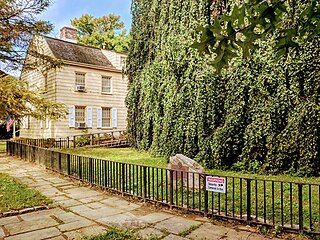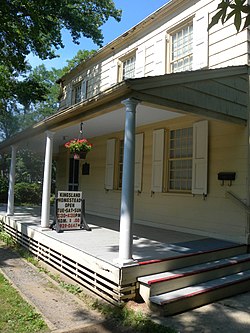
The Unisphere is a spherical stainless steel representation of the Earth in Flushing Meadows–Corona Park in the borough of Queens in New York City, New York, United States. The globe was designed by Gilmore D. Clarke as part of his plan for the 1964 New York World's Fair. Commissioned to celebrate the beginning of the space age, the Unisphere was conceived and constructed as the theme symbol of the World's Fair. The theme of the World's Fair was "Peace Through Understanding", and the Unisphere represented the theme of global interdependence, being dedicated to "Man's Achievements on a Shrinking Globe in an Expanding Universe".

Green-Wood Cemetery is a 478-acre (193 ha) cemetery in the western portion of Brooklyn, New York City. The cemetery is located between South Slope/Greenwood Heights, Park Slope, Windsor Terrace, Borough Park, Kensington, and Sunset Park, and lies several blocks southwest of Prospect Park. Its boundaries include, among other streets, 20th Street to the northeast, Fifth Avenue to the northwest, 36th and 37th Streets to the southwest, Fort Hamilton Parkway to the south, and McDonald Avenue to the east.

Flushing is a neighborhood in the north-central portion of the New York City borough of Queens. The neighborhood is the fourth-largest central business district in New York City. Downtown Flushing is a major commercial and retail area, and the intersection of Main Street and Roosevelt Avenue at its core is the third-busiest in New York City, behind Times Square and Herald Square.

The New York City Landmarks Preservation Commission (LPC) is the New York City agency charged with administering the city's Landmarks Preservation Law. The LPC is responsible for protecting New York City's architecturally, historically, and culturally significant buildings and sites by granting them landmark or historic district status, and regulating them after designation. It is the largest municipal preservation agency in the nation. As of July 1, 2020, the LPC has designated more than 37,800 landmark properties in all five boroughs. Most of these are concentrated in historic districts, although there are over a thousand individual landmarks, as well as numerous interior and scenic landmarks.

The Flushing–Main Street station is the eastern terminal on the IRT Flushing Line of the New York City Subway, located at Main Street and Roosevelt Avenue in Downtown Flushing, Queens. It is served by the 7 local train at all times and the <7> express train during rush hours in the peak direction.

Hamilton Grange National Memorial is a historic house museum within St. Nicholas Park in the Hamilton Heights neighborhood of Manhattan in New York City. Operated by the National Park Service (NPS), the structure was the only home ever owned by Alexander Hamilton, a U.S. Founding Father. The house contains exhibits for visitors, as well as various rooms with restored 19th-century interiors. Originally located near present-day 143rd Street, the house was moved in 1889 to 287 Convent Avenue before being relocated again in 2008 to St. Nicholas Park. The structure is a New York City designated landmark and a United States national monument, and it is listed on the National Register of Historic Places.

College Point is a working-middle-class neighborhood in the New York City borough of Queens. It is bounded to the south by Whitestone Expressway and Flushing; to the east by 138th Street and Malba/Whitestone; to the north by the East River; and to the west by Flushing Bay. College Point is a mostly residential ethnically diverse community with some industrial areas. The neighborhood is served by several parks and contains two yacht clubs.

The Queens Historical Society, which was founded in 1968 by Margaret I. Carman after a merger with the Kingsland Preservation Commission, is dedicated to preserving the history and heritage of Queens, New York and interpreting the history of the borough as it relates to various historical periods. The historical society is the only museum about Queens' history within the borough and is located in Kingsland Homestead, which is a historic house museum within Weeping Beech Park.

Broadway–Flushing is a historic district and residential subsection of Flushing, Queens, New York City. The neighborhood comprises approximately 2,300 homes. It is located between 155th and 170th Streets to the west and east respectively, and is bounded on the north by Bayside and 29th Avenues, and on the south by Northern Boulevard and Crocheron Avenue. Broadway–Flushing is listed on the National Register of Historic Places.

Village Preservation is a non-profit organization which advocates for the preservation of architecture and culture in several neighborhoods of Lower Manhattan, New York. Since it began in 1980, it has engaged in efforts to attain landmark status for a variety of sites like the Stonewall Inn and Webster Hall. The organization and its Executive Director, Andrew Berman, have been described as influential in New York real estate, while some of its activities to prevent development and to support restrictive zoning have attracted criticism.

St. James Church is a historic Episcopal church building at 86-02 Broadway in the Elmhurst neighborhood of Queens in New York City. It is the city's oldest surviving Anglican building and Church of England mission church. It is also alternatively called the Old St. James Church to distinguish it from the St. James Episcopal Church two blocks away.

The RKO Keith's Theater was an RKO Pictures movie theater at 129-43 Northern Boulevard in the Flushing neighborhood of Queens in New York City. It was designed by architect Thomas W. Lamb and built in 1928. While the RKO Keith's had a plain three-story facade, its interior was elaborately designed in a Spanish Baroque Revival style. The theater had a square ticket lobby and an oval grand foyer, which led to the double-level auditorium. The auditorium was designed as an atmospheric theater with a blue ceiling and gilded-plaster decorations; it contained 2,974 seats across two levels. There were also four lounges and a mezzanine promenade.

The Magnolia grandiflora is a historic tree at 679 Lafayette Avenue in Bedford–Stuyvesant, Brooklyn, New York City. The specimen is a rare example of a flourishing laurel magnolia growing as far north as New York, having been brought as a seedling from North Carolina and planted around 1885 by William Lemken. It is one of two trees that were made New York City designated landmarks; the other was the now-felled Weeping Beech in Flushing, Queens.

The Weeping Beech was a historic tree located at Weeping Beech Park in Flushing, Queens, New York City. It was the mother of all European weeping beeches in the United States.

Bowne Park is a 11.79-acre (4.77 ha) park in Broadway–Flushing, Queens, New York, east of downtown Flushing. It is bordered by 29th Avenue on the north, 32nd Avenue on the south, 155th Street on the west, and 159th Street on the east. The park consists of a playground, basketball courts, bocce court, and a kettle pond. The area immediately surrounding the park, developed in the late 19th and early 20th centuries, was originally also marketed as "Bowne Park" and is part of modern-day Murray Hill and Broadway–Flushing.

The Pepsi-Cola sign is a neon sign at Gantry Plaza State Park in the Long Island City neighborhood of Queens in New York City. The sign, visible from Manhattan and the East River, was built in 1940 and originally installed atop PepsiCo 's bottling factory nearby. It is composed of a 50-foot (15 m) depiction of a Pepsi bottle, as well as lettering that reflected PepsiCo's logo when the sign was commissioned.

Margaret Isabel Carman was an American teacher and historian, best known for her contributions to the preservation and dissemination of the history of Flushing, New York. Born into a prominent family with a rich history, Carman spent her entire career teaching at Flushing High School, the oldest public secondary school in New York City, where she inspired generations of students to take an interest in history and become active citizens.
























